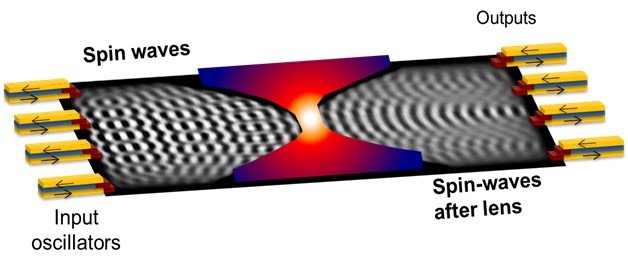Research Themes

Theme 1: Spin-orbit torque materials
Theme 1 will develop spin-orbit torque (SOT) materials based on thin films of Dirac and Weyl semimetals and three-dimensional topological insulators (TIs). These thin films will be grown by molecular beam epitaxy (MBE) and sputtering and will be combined with both metallic and insulating ferro/ferrimagnets (FMs) for the fabrication of high efficiency SOT devices such as nano-oscillators.
The first task of the theme is devoted to the synthesis of thin films of Dirac semimetals (Cd3As2) and Weyl semimetals and their integration into heterostructures. This task will identify appropriate substrates and seed layers and develop growth protocols that produce single crystal wafer scale films using MBE and highly oriented wafer scale films by sputtering. The second task is devoted to the synthesis of thin films of three dimensional (3D) TIs. The resulting heterostructures will be patterned into SOT-based oscillators for different applications. The third task is to develop antiferromagnetic materials along with devices which rely on Néel ordering switching, and antiferromagnet domain wall motion will be investigated.

Theme 2: Ultra-low loss spin-wave materials
Theme 2 vision is to develop new materials for the processing of information using spin waves and to integrate these materials into heterostructures for generating, transmitting, and detecting spin waves in prototypical devices. The ideal spin wave material should have low loss, an anisotropy that can be engineered through interfacial and bulk electronic structure, and it must be integrated with a high-bandwidth source and detector.
The first task of the theme will advance the state-of-the-art by synthesizing new classes of spin wave materials based on magnetic garnets and Heusler alloys. Their properties in both films and nanostructures will be optimized through a program of structural and magnetic characterization, microwave measurements, and theory and simulation. New approaches to high-frequency operation with low loss will be pursued, including spin wave channels based on antiferromagnetic materials. In the second task, the theme will pursue new heterostructures for integrating spin wave materials into devices. This will include implementing spin wave generators and detectors using spin-orbit torque as well as a higher risk but potentially high payoff approach in which magneto-electric or magneto-elastic coupling are used for generation and detection.

Theme 3: Magneto-ionic materials
Theme 3 vision is to develop mechanisms and heterostructures in which magnetic properties can be manipulated by the application of an electric field via a small gate voltage through controlled motion of an ionic species in solid-state devices. The goal is to dramatically advance the state-of-the-art in magneto-ionic control of magnetism, by achieving reliable low voltage, low energy, high endurance, and dynamic analog control over magnetic properties at room temperature and integrating this functionality into magnetic devices such as MTJs. This will enable magnetic logic devices in which a large dynamic range analog manipulation of the output is possible.
Such devices will also be relevant for a variety of demonstration platforms, including proof-of-principle MTJ crossbars for neuromorphic computing. Key features of the theme effort include: (1) The use of active magnetic structures based on both magnetic metals and oxides; (2) The exploration of magneto-ionic concepts based on getter layers; (3) An emphasis on materials fundamentals to understand the mechanisms of magneto-ionic control and the fundamental limits on manipulation speed, durability, and generality; and (4) The development of platforms for device demonstrations in neuromorphic and stochastic computing.